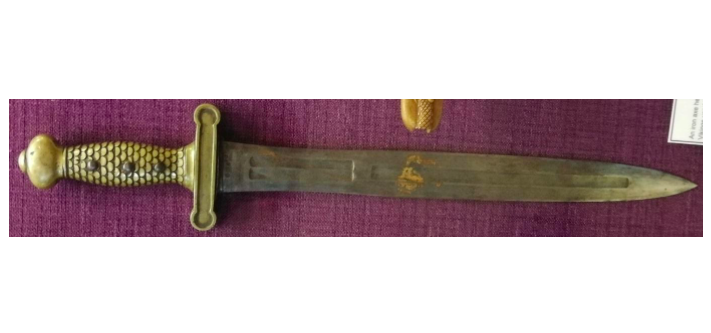
Disclaimer: Any views expressed by individuals and organisations are their own and do not in any way represent the views of The Heritage Portal. If you find any mistakes or historical inaccuracies, please contact the editor.
The gladius is a short sword which narrows near the base of the blade. This shape makes the sword effective at cutting as well as thrusting. The gladius is best known as a primary weapon of the Roman legions. It forced Roman soldiers to get in close to their enemies and to kill quickly. It was the Roman defeats of the famous Greek hoplites that showed the sword to be more deadly than the spear.
The Greek hoplites used swords as secondary weapons and could not compete with the more mobile and diversified Roman forces. Phalanx formations had become the pinnacle of spear combat, but hoplites were developed to use lesser trained soldiers who were not as good with their swords when a phalanx broke.
The earliest surviving examples of the Roman gladius come from the first century BCE, but they were produced in the Rhineland, and the earliest records of the Roman gladius refer to it as “the Spanish sword”. The four-ring scabbard pattern of the Roman gladius is a copy of the Spanish scabbard. It appears that the gladius was in widespread use in the Iberian Peninsula and in Germanic territory where the gladius is referred to as the Mainz-type sword.
The earliest widespread Roman adoption of the short sword begins with 5th Century BCE Celtic attacks through Northern Italy. The Celts had arrived with new fighting methods and after sacking Rome, the Romans searched for new methods of defending themselves. The problems Rome faced included the large stature of the Celts, their high quality weapons, and their devastating massed charge. Rome abandoned the round shield which the Celtic weapons easily cut through and adopted the oval shaped shield with metal-reinforced edges. To break up Celtic charges, brave Roman soldiers were chosen to stand out in front with swords and javelins. Their javelins would begin to break up the charge and short swords would be all they could use once overrun. These soldiers were called principes. The soldiers behind the principes were trained to use their heavier shields to take the initial Celtic hit and then attack with their short sword beneath the Celtic shield. In this way, the shorter Romans took advantage of the large Celts exposing themselves to attack when raising their arms to strike. Spear and shield soldiers were still retained behind in ranks for the sword wielding soldiers to retreat passed if necessary.
Sword use as a primary weapon in the Roman army continued to expand for defensive tactics. When nearly half the Roman army had replaced spears with swords, many were still called hastati or spearmen. Over time the necessarily brutal tactics which the Romans employed in combat to defend against the Celts was turned to offense and helped Rome build a massive empire.
Over generations the gladius began to be used more and more as a backup weapon or as a utility sword, and ultimately for ceremonial purposes. The gladius was however still a weapon that could reasonably see combat well into the 19th Century. The gladius in the Ditsong Museum Collection was produced by France as a bandsman sword in 1815 at the time of the Battle of Waterloo.
David Rilley-Harris is the Curator of Edged Weapons and an Educational Officer at the Ditsong National Museum of Military History.
Comments will load below. If for any reason none appear click here for some troubleshooting tips. If you would like to post a comment and need instructions click here.
